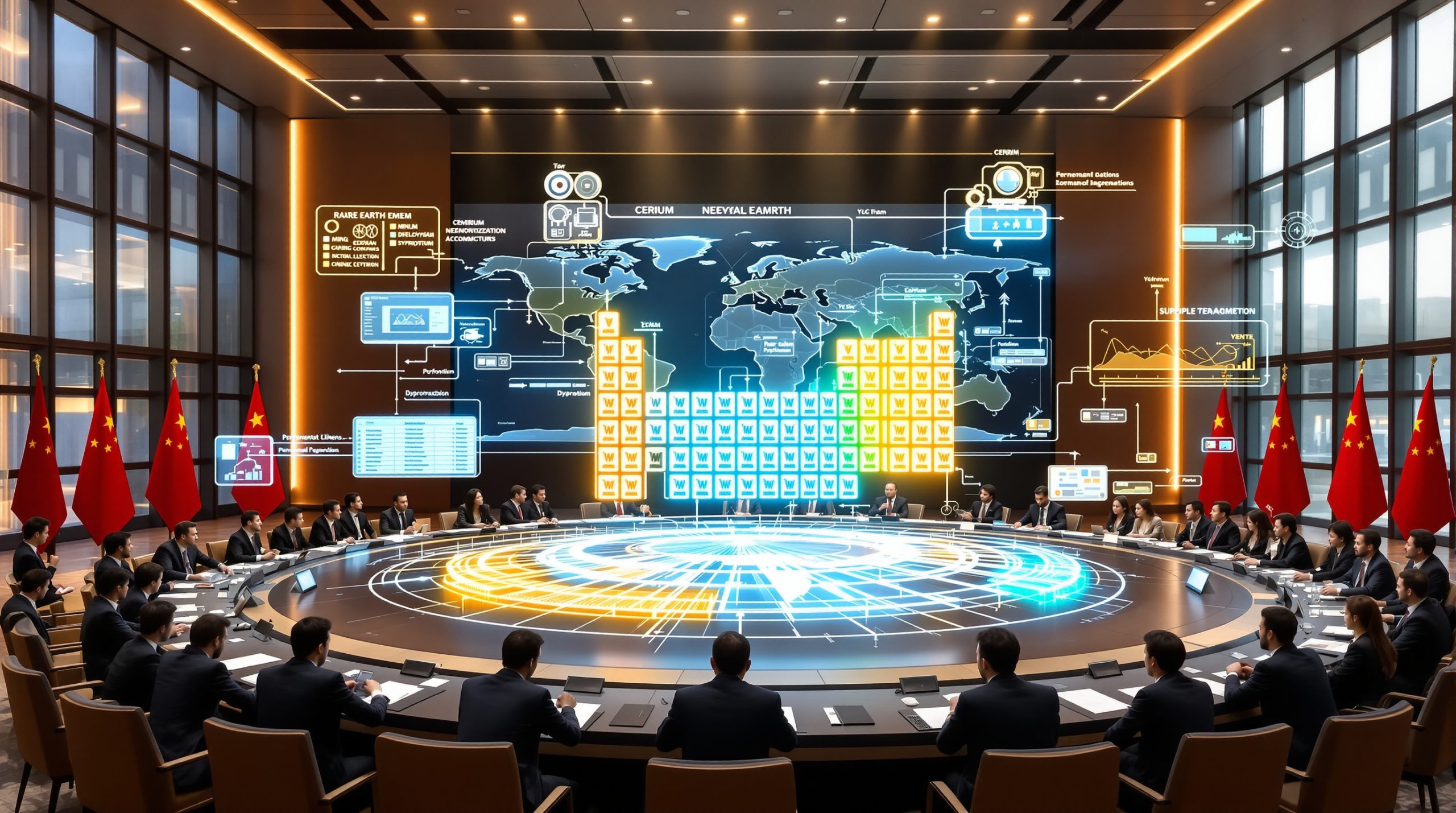China's approach to rare earth standards represents a comprehensive industrial policy framework that extends far beyond technical specifications. The china rare earth standards conference held in November 2025 marked a pivotal moment in global supply chain governance, establishing technical foundations that will influence international markets for decades to come.
Furthermore, this development creates ripple effects through every layer of modern technology infrastructure, from electric vehicle manufacturing to defense systems. The implications reach across multiple sectors dependent on rare earth supply chains, making understanding these dynamics essential for strategic planning.
Understanding China's Strategic Framework for Rare Earth Standardization
China's approach to rare earth standardization represents a comprehensive industrial policy framework designed to consolidate technical specifications across the entire supply chain. This initiative encompasses mining extraction protocols, separation technologies, processing methodologies, and advanced manufacturing standards for permanent magnets and electronic components.
The November 2025 National Rare Earth Standardization Technical Committee meeting in Tonglu County, Zhejiang Province brought together over 150 industry experts to establish technical foundations that will influence global operations. The conference resulted in 26 new technical standards receiving final approval, with an additional 30 standards validated for 2026 implementation.
The Four-Pillar Implementation Strategy
Cao Yiding from China's market regulation authority outlined four strategic directives that frame the standardization approach:
Policy Alignment Directive: Standards must align with state industrial policy objectives to advance the sector toward high-end, intelligent, and green development. This reflects China's broader industrial transformation goals outlined in national planning documents.
Innovation-to-Standards Acceleration: Integration of research breakthroughs and new technologies into commercially codified standards must be expedited. Consequently, this compresses the timeline between laboratory innovation and industry-wide standardization.
International Cooperation Enhancement: Tracking international rare earth standard trends, comparing with foreign systems, and harmonising standards to expand China's role in global norm-setting represents a strategic diplomatic component.
Nationwide Implementation Enforcement: Strengthening training and ensuring strict implementation across product design, production, quality control, and certification creates uniform operational requirements.
| Strategic Pillar | Implementation Focus | Global Impact |
|---|---|---|
| Policy Alignment | Integration with national industrial objectives | Shapes international compliance requirements |
| Innovation Acceleration | Rapid technology-to-standard conversion | Influences global R&D priorities |
| International Cooperation | Harmonisation with foreign systems | Affects global trade protocols |
| Nationwide Implementation | Comprehensive industry adoption | Sets global operational benchmarks |
Market Structure Transformation Through Standardization
The standardisation push fundamentally alters competitive dynamics by establishing technical barriers that favour Chinese production methodologies. China's dominance in rare earth processing, controlling approximately 90% of global processing capacity according to the U.S. Geological Survey, provides structural leverage for implementing these standards globally.
However, this creates asymmetric advantages for domestic producers while potentially increasing compliance costs for international competitors. Foreign operations must either invest in retrofitting to meet new Chinese specifications or accept technical barriers that limit market access opportunities.
Supply Chain Integration Effects
The standardisation framework operates through three integrated levels:
- Upstream Integration: Mining and separation standards that optimise for Chinese processing facilities
- Midstream Optimisation: Refining protocols that align with domestic industrial capacity
- Downstream Standardisation: Manufacturing specifications tailored to Chinese technological capabilities
China extracted approximately 210,000 metric tons of rare earth oxide equivalent in 2023, representing roughly 70% of global production. In addition, this production dominance combined with processing control creates multiple pressure points where standardisation influences global supply chain operations.
Technical Standards Approved During the 2025 Conference
The November 2025 conference represented the fastest standardisation rollout in China's rare earth sector history, addressing critical elements across the supply chain. The approved standards specifically target both technical specifications and environmental compliance frameworks.
Primary 2025 Standard Approvals
The 26 newly approved standards cover four main categories:
Cerium-Praseodymium-Neodymium Oxide Specifications: These standards establish purity levels, elemental distribution parameters, and impurity thresholds for the most commercially important rare earth oxides used in permanent magnet production.
Advanced Separation Technology Protocols: Technical methodologies covering solvent extraction efficiency, ion-exchange processes, and environmental containment measures for rare earth separation operations.
Environmental Compliance Frameworks: Standards addressing tailings management, acid recovery systems, emission limits, and water treatment protocols that align with China's dual-carbon neutrality objectives.
Quality Control Methodologies: Comprehensive testing procedures, certification requirements, and batch validation protocols ensuring consistent production quality across facilities.
2026 Pipeline Standards Breakdown
The 30 standards validated for 2026 implementation focus on emerging applications and advanced processing:
| Standard Category | Count | Technical Focus | Strategic Importance |
|---|---|---|---|
| Scandium Concentrate Processing | 12 | Purification efficiency, cost optimisation | Advanced alloy applications |
| Neodymium-Aluminium Alloy Targets | 8 | Sputtering target specifications, purity requirements | Electronics manufacturing |
| Heavy REE Purification | 6 | Dysprosium, terbium, yttrium processing | Defence and high-tech applications |
| Magnet Production Efficiency | 4 | Sintering parameters, magnetic performance | Electric vehicle and renewable energy |
An additional 12 national and industry standards received approval on November 13, 2025, covering scandium and neodymium-aluminium alloy targets specifically. This comprehensive approach addresses the full spectrum from upstream concentrate processing through advanced manufacturing applications.
Geopolitical Implications of Standards-Based Competition
China's standardisation strategy functions as a non-tariff trade instrument, creating structural dependencies that extend beyond simple supply relationships. For instance, by establishing the technical foundation for global rare earth operations, China positions itself as the default rule-setter for an entire industry sector.
This approach leverages China's control over approximately 95% of permanent magnet production globally, according to U.S. Department of Energy assessments. The standardisation framework reinforces this dominance by creating technical barriers favouring Chinese processing methodologies.
Strategic Leverage Mechanisms
The standards operate through multiple competitive advantage channels:
First-Mover Advantage: Early standardisation creates path dependency for global adoption, making it costly for other nations to establish competing technical frameworks.
Technical Barriers: Complex compliance requirements favour established Chinese operations with existing infrastructure optimised for these specifications.
Innovation Control: Standards influence the direction of technological development globally by establishing technical parameters that guide research and development priorities.
Key Insight: China frames rare earth standards as mechanisms to become the default global rulebook, giving Beijing structural influence over prices, environmental norms, and market access across critical supply chains.
Integration with Export Control Policies
The November 2025 china rare earth standards conference occurs within a broader policy framework that includes export controls on rare earth materials and technologies. These policies work synergistically to create comprehensive governance over rare earth supply chains.
Recent export control measures target medium and heavy rare earth elements, mining and processing technology, production equipment, and battery materials. Furthermore, the controls include extraterritorial application provisions affecting foreign-produced goods using Chinese technology.
Comprehensive Control Framework
| Control Mechanism | Geographic Reach | Industry Effect |
|---|---|---|
| Technology Licensing | Global (foreign-produced goods using Chinese tech) | Increases compliance complexity |
| Material Restrictions | Direct exports plus re-exports | Creates supply chain bottlenecks |
| Service Limitations | Technical support and maintenance | Affects operational continuity |
| Standards Requirements | Processing and manufacturing specifications | Influences global technical adoption |
This integrated approach creates multiple pressure points where Chinese policy influences global rare earth operations, from initial mining through final product manufacturing.
Western Supply Chain Security Implications
Western economies face compound risks from China's integrated approach combining technical standards with export restrictions. Consequently, this creates vulnerability across multiple critical sectors dependent on rare earth inputs.
The U.S. Department of Energy identifies critical dependencies in permanent magnet production, electronics manufacturing, defence systems, and renewable energy technology. Each sector faces different risk profiles based on specific rare earth element requirements and processing complexity.
Strategic Response Requirements
Addressing these vulnerabilities requires coordinated action across multiple dimensions:
Technical Independence: Development of alternative standards frameworks that reduce dependence on Chinese specifications while maintaining international compatibility.
Supply Diversification: Strategic investment in non-Chinese production capacity, particularly for heavy rare earth elements where Chinese dominance approaches near-monopoly levels.
Innovation Acceleration: Breakthrough technologies that bypass current Chinese standards through alternative processing methods or substitution materials.
Recycling Infrastructure: Urban mining and recycling capabilities that reduce primary supply dependencies while creating domestic rare earth sources.
Investment Strategy Considerations
The standardisation developments create distinct investment opportunities and risks across the rare earth value chain. However, understanding these dynamics becomes essential for strategic asset allocation decisions.
Risk-Return Matrix for Rare Earth Investments
High-Risk, High-Return Opportunities:
- Non-Chinese heavy rare earth development projects
- Alternative processing technologies that bypass Chinese standards
- Recycling and urban mining ventures targeting strategic elements
- Defence-grade rare earth supply chain investments
Moderate-Risk Investment Themes:
- Established Australian rare earth producers with processing capabilities
- North American integrated mining and processing facilities
- European rare earth recycling and separation operations
- Technology companies developing rare earth alternatives
Portfolio Strategy Framework
Investment Thesis: China's standardisation push creates structural opportunities for investors supporting supply chain diversification initiatives, particularly in heavy rare earth elements where Chinese dominance creates the most significant strategic vulnerabilities.
Investment considerations must account for:
- Regulatory support from Western governments for supply chain security
- Technical feasibility of alternative processing methods
- Market demand growth in electric vehicles and renewable energy
- Geopolitical risks affecting international trade relationships
Future Market Dynamics and Scenario Analysis
The 2025 china rare earth standards conference represents a pivotal moment in rare earth geopolitics, establishing technical foundations that will influence global supply chains for decades. Multiple scenarios could emerge based on international responses and technological developments.
Scenario Analysis Framework
Scenario 1: Standards Harmonisation
- Global adoption of Chinese standards reduces technical barriers
- Streamlined supply chains emerge but with concentrated Chinese control
- Cost efficiencies develop through standardised processes
- Western strategic vulnerabilities increase
Scenario 2: Standards Fragmentation
- Competing technical frameworks develop (US, EU, China)
- Higher compliance costs but distributed control structures
- Regional supply chain clusters form around different standards
- Innovation occurs through competitive technical development
Scenario 3: Technology Leapfrogging
- Breakthrough technologies bypass current standards entirely
- Disruption of established market structures creates new opportunities
- Alternative materials or processing methods reduce rare earth dependence
- Competitive dynamics shift toward innovation leaders
Long-Term Strategic Implications
The standardisation framework establishes technical parameters that will guide investment decisions and industrial policy for decades. Companies and governments must evaluate their strategic positioning within this evolving competitive landscape.
Key factors influencing long-term outcomes include:
- Western government support for alternative supply chains
- Technological breakthroughs in rare earth alternatives or recycling
- China's willingness to maintain cooperative international relationships
- Global demand growth in rare earth-intensive technologies
Frequently Asked Questions
What specific rare earth elements are most affected by these standards?
The new standards particularly impact medium and heavy rare earth elements including dysprosium, terbium, and yttrium, which are critical for high-performance permanent magnets and advanced electronics. The 2026 pipeline includes specific standards for scandium concentrate processing and neodymium-aluminium alloy targets.
How do these standards affect rare earth pricing mechanisms?
Standardisation can create price premiums for compliant materials while potentially reducing costs through operational efficiencies. The net effect varies across different market segments, with heavy rare earth elements likely experiencing the most significant pricing impacts due to concentrated Chinese supply.
What timeline should companies expect for global implementation?
Based on the four-pillar strategy outlined at the conference, expect accelerated implementation through 2026-2027 for approved standards. International harmonisation discussions likely extend through 2028-2030, depending on Western government responses and industry adoption rates.
How can investors evaluate opportunities in this changing landscape?
Focus on companies developing alternative supply chains outside Chinese control, particularly in heavy rare earth elements. Consider investments in recycling technology, alternative processing methods, and established producers with integrated operations in Western-aligned countries.
Disclaimer: This analysis involves forecasts and speculation about future market developments. Rare earth investments carry significant risks including regulatory changes, technological disruption, and geopolitical tensions. Readers should conduct independent research and consult qualified advisors before making investment decisions.
Looking for the Next Major Rare Earth Discovery?
Discovery Alert provides instant notifications on significant ASX mineral discoveries, powered by its proprietary Discovery IQ model, helping investors capitalise on rare earth and critical mineral opportunities before the broader market reacts. Understand why historic discoveries can generate substantial returns by exploring Discovery Alert's dedicated discoveries page, then begin your 30-day free trial today to position yourself ahead of emerging opportunities in this rapidly evolving sector.



